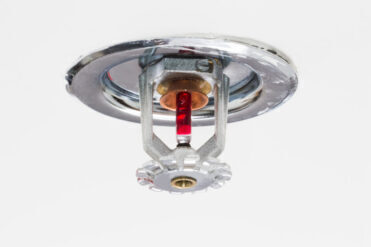Inspection, testing, and maintenance (ITM) of fire sprinkler systems must be done correctly. Maintaining a temperature of at least 40 degrees (F) is crucial to avoid freezing. The majority of the time, dry pipe or antifreeze systems are used to cover sprinkler areas that cannot be kept at 40 degrees or above. Before the onset of cold weather, antifreeze systems must be inspected, and if they are found to be inadequate to defend against the required temperatures, they must be changed. The dry pipe valve’s wet portions must be kept at a temperature of no less than 40 degrees (F) and the enclosure must be examined regularly.
The elimination of any water that could gather in a dry system must be part of a maintenance routine. It is important to drain dry systems correctly to avoid damage and expensive repairs.
One of the key factors contributing to fire sprinkler system failures is improper maintenance. According to NFPA 25, Standard for Inspection, Testing, and Maintenance of Water-Based Fire Prevention Systems, fire sprinkler systems must be properly inspected, tested, and maintained (ITM). Systems that are exposed to the cold are particularly susceptible.
How To Prevent Freezing Problems
These systems are particularly vulnerable to disastrous failure in the winter. Throughout the winter, one of the more frequent service calls is for frozen sprinkler pipes. In order to prevent the sprinkler pipes from freezing, it is crucial to maintain a temperature of at least 40 degrees (F). The entryways, vestibules, stairwells, vacant spaces, skylights, and improperly insulated rooms are just a few of the places that might cause problems in the winter that go unnoticed throughout the summer.
Areas with sprinklers that can’t be kept at 40 degrees (F) or above are typically covered with a dry pipe or antifreeze system. To prevent freezing, these kinds of systems could need more extensive evaluations and regular maintenance. To ensure that the antifreeze solution will protect against the predicted temperatures for the location where the systems are placed, antifreeze systems should be tested before the arrival of freezing weather. They must be emptied and supplied with a new specified antifreeze satisfying the standards of NFPA 25, Section 5.3.4, if they are unable to protect to the necessary temperatures. (courtesy: Vince Powers)
Required Maintenance
The enclosure must be checked daily to ensure the minimum temperature is maintained and once a week if the room has a low-temperature alert. The wet parts of the dry pipe valve must be kept at a minimum of 40 degrees (F). At the start of cold weather, after each system operation, and as needed after that, the low point and auxiliary drains must be emptied. Over the cold season, the frequency of operation of these drains will depend on how much condensation is present in the drain. Depending on the state of the system and the circumstances of the building, this can be a daily, weekly, or monthly necessity.
The NFPA 25 2020 edition’s Section 13.4.5.3.2 emphasizes the aforementioned criteria, and the annexe sections clarify the significance of this process and provide some helpful context for this fundamental dry pipe system maintenance phase.
The following is stated in section A.13.4.5.3.2:
- A maintenance schedule must include the removal of water that may accumulate in a dry system.
- If dry systems are not properly drained, the structure and system may be damaged, necessitating costly repairs.
- There should be software in place to keep an eye on the system and the necessary operation of any auxiliary drains.
- The frequency of auxiliary drain operation can be adjusted to weekly or longer intervals as needed after a dry system has functioned for several days with no water flow. The auxiliary drains should be operated every day after the dry system has operated.
- The frequency of operation for the auxiliary drains should decrease as the outflow of stored water increases when preparing for freezing weather.
- Before draining the system low points, quick opening devices should be temporarily taken out of operation if they are present.
- 1. Lower the valve.
- 2. Drain the accumulating water by opening the lower valve.
- 3. Shut the bottom valve, then open the top valve to let more water build up.
- 4.Continue doing this until the water stops flowing.
- 5. Replace the bottom valve’s plug, nipple, and cap.
To Wrap Up
In spite of the fact that cold weather affects all industries, it may be disastrous for the fire protection sector. A fire protection system’s ability to perform in an emergency might be completely lost if it is not properly maintained. To make sure that these systems are prepared to function in an emergency, it is crucial to make sure they are well maintained.
Courtesy: Vince Powers, an ITM Expert at the NFSA, wrote this edition of TechNotes.



